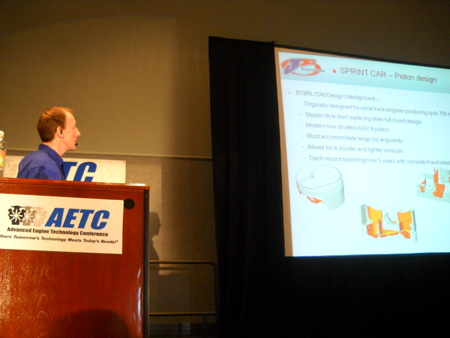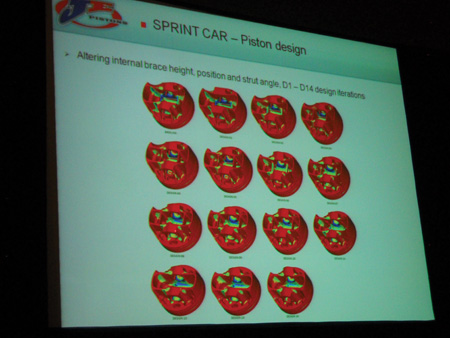People always ask what I get out of going to AETC? The simple 30 second elevator answer is you take the smartest people you know, or have ever met, and throw them all in a room together for three days and see what comes out of it. It usually doesn’t disappoint. As expected, a lot of good information came out of this year’s AETC.
Breaking out of the themes for last two years being specific engine families, this year’s theme was “Circle Race Engine Technology.” And being that Orlando isn’t far from the home of NASCAR, there were some heavy hitters on hand to not only give presentations but to listen to the other speakers as well.
Some of the noted speakers included Doug Yates of Roush Yates Engines, who presented “An Insider’s View to Building Championship Caliber Engines.” Yates said that he had been asked by Comp Cams’ Scooter Brothers to speak at AETC ten years ago, but then got married and postponed it until now. He said the design of the new Ford Cup FR9 engine was done all on computer and then mocked up in plastic before one part was ever cast or machined. Finite element analysis (FEA) helped the team understand the weak points of the engine and hot spots of each part.
Yates explained that what he learned was to build reliability first. He said you can build power but if it won’t last it’s not worth anything. Through Spintron testing they were also able to find several gains including 500 rpm and more valvetrain stability. By using all the tools and software analysis, Yates said it helped bring the FR9 to the next level.
Clemson University’s Dr. Robert Prucka gave a very well received presentation on “Advanced Combustion Analysis and Application to Performance Engine Development.”
Dr. Prucka reminded attendees of the importance of making data-driven decisions; you always want to gather as much data as you can. He said you can measure power on the dyno but it starts in the combustion chamber, which was the focus of much of his presentation.
Most of what we know about combustion has been from evaluating data outside of the combustion chamber. Dr. Prucka used sensors in the combustion chamber to measure and evaluate the combustion process in order to find out what happens inside. He said that data acquisition is the key to understanding and that a Formula One car with data acquisition pulls 27 terabytes of data off the car during a race.
Like Dr. Prucka, Earnhardt Childress Racing’s Engine Technical Director Dr. Andy Randolph, one of the foremost combustion experts in the world, gave his presentation on “The Advanced Science of NASCAR Cup Engine Optimization.” Dr. Andy, as he likes to be called, gave one of the more entertaining and informative presentations of the conference. He admitted that Cup engines use pretty old architecture but believes they polish it up well. He said every year his team scrapes and claws to find 10 or 15 horsepower, and he believes that trend is likely to continue for the next few years. Dr. Andy noted that when you develop an approach to engine development you can be successful in pretty much any category of racing.
One of the more interesting presentations was by Stephen Golya, Principal R&D Engineer for JE Pistons about how its latest 410 Sprint Car piston was designed. Golya came to the conference, like many others, with an impressive list of credentials including stints working on various development projects for teams in Formula One, NASCAR, NHRA and Japanese GT.
After relocating from England to California, Golya started a tutoring program within JE Pistons to offer engineers the ability to design and analyze their ideas, to continue to evolve piston design. Golya has received two patents with JE Pistons for his development ideas so far, and by the looks of things there will be more to come.
In his presentation, Golya said that one of his first projects when he came to the U.S. was to design a new piston for 410 cid sprint car engines. The old piston had been pushed to its limits as engines had evolved from originally producing 750 horsepower when the piston was designed 5 years ago. The old design featured a slipper-style skirt that replaced an older iteration with a full-round skirt. It is made of modern alloy Al2618 with a box strut design. The piston was made to accommodate large rod angularity due to the long throw and it also had a shorter and lighter wrist pin.
Golya said the older piston started having more failures because racers and engine builders had produced more power and they were seeing failures in the skirt struts, buckling under compressive loads. The designs weren’t failing, he said, they’re just experiencing certain events in the weakest areas. The 2618 would go into fatigue after 100,000 cycles so engineers try to build in a bigger safety margin.
In designing this piston, Golya compared it to early cell phone technology. He reminded us that the first phones were big brick phones. But today, the iPhone is a mini computer. It’s light years ahead.
The goals for the new design can be carried over to virtually every other piston manufacturer’s design process:
• Eliminate strut cracking;
• Increase fatigue life and durability;
• Reduce reciprocating mass; and
• Improve overall performance.
Golya said it’s all about packaging – rings, valves, rod, etc. Everything has to be considered to make a piston. Some of the strategies for the new piston meant increasing the strut stiffness to reduce compressive stress concentrations; reduce crown stresses, especially around the widows peak; improve pin bore contact pressures; maintain skirt contact pressures; reduce reciprocating weight; and it must be forgeable and cost effective as well.
According to Golya, if you allow skirts to flex, much like a chair, there will be a buckling mode before it goes into failure. But if you make the struts straighter, you’ll have less stress, which was a revelation. Golya said that usually if you are stiffening something, you are imparting stress somewhere else. It took 14 design iterations to come up with the best design. You try to move the stresses, he explained, as best as you can from the crack location points.
Golya then showed a slide of the results of testing and CAD Cam designs and each of the small gains and losses from each iteration were obvious.
Other speakers at the 21st AETC included Keith Dorton, Ron Shaver, Bill Shlieper, Dr. Dean Hill, Matt Hartford, Gary Stanton, Greg West, plus a larger panel of speakers than ever.
It was a jam-packed three days of speakers and discussions with other attendees, many of whom agreed that the conference had hit another home run. This was also evidenced by the large number of sponsors who had signed up to give away products and to hopefully influence the hearts and minds of the attendees. And from all estimates the crowd on hand was even larger than the year before. 














